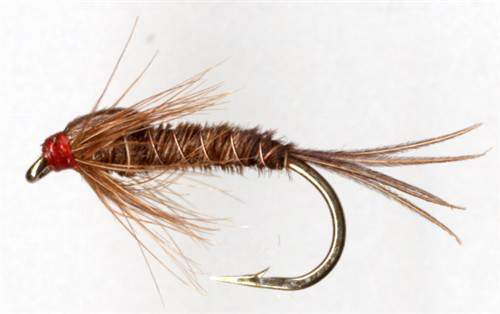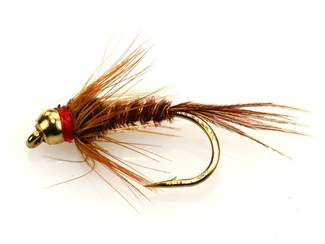Pheasant Tail Nymph - the closest you can get to a fly for all seasons
 Of all the fly fishing flies obtainable it truly is the Pheasant Tail Nymph (PTN) which may be most indicative of real trout food in the course of the season. The original pattern tied by English River Keeper Frank Sawyer, utilizes the butt ends belonging to the Pheasant to develop a wing case. A practical variant is the fly tied as a gold bead head. Frank didn't aim to indicate legs in the pheasant tail nymph seeing that he had observed that nymphs tuck them inwards while swimming. He devised the pheasant tail nymph to be used at the River Avon in Wiltshire, Southern England. it abruptly grew to become world famous. Frank's book 'Nymphs and Trout' first published in 1958 describes the method of tying plus fishing the pheasant tail nymph. The key theme in his fly fishing flies is simpleness. Frank Sawyer is also legendary for the Sawyer Killer Bug, tied with the legendary Chadwick’s 477 wool originally used for darning socks!
Of all the fly fishing flies obtainable it truly is the Pheasant Tail Nymph (PTN) which may be most indicative of real trout food in the course of the season. The original pattern tied by English River Keeper Frank Sawyer, utilizes the butt ends belonging to the Pheasant to develop a wing case. A practical variant is the fly tied as a gold bead head. Frank didn't aim to indicate legs in the pheasant tail nymph seeing that he had observed that nymphs tuck them inwards while swimming. He devised the pheasant tail nymph to be used at the River Avon in Wiltshire, Southern England. it abruptly grew to become world famous. Frank's book 'Nymphs and Trout' first published in 1958 describes the method of tying plus fishing the pheasant tail nymph. The key theme in his fly fishing flies is simpleness. Frank Sawyer is also legendary for the Sawyer Killer Bug, tied with the legendary Chadwick’s 477 wool originally used for darning socks!
 The Pheasant Tail is, no doubt, the best may fly nymph imitation ever designed as soon as you examine the natural active darter nymph you may comprehend why. By way of example just search at the photograph of a Blue Winged Olive nymph and you will notice that it is an excellent match for it's profile and color. The nymph is intended to sink fast whilst presented up stream to a subsurface feeding trout. It really works efficiently while in the moving water of chalk-streams and then the still water of reservoirs. It's one of the most popular fish fly fishing flies used. Various kinds of may flies appear all year long, and the nymph stage is the easiest one for trout to search out consistently. May fly's nymphs are adaptable as they could live in fast, turbulent water, or in slow or still water environments. As a result of shuffling the gravel in a stream or lake, and looking on stream bed rocks, you will find the nymphs but it's an easy matter of matching the fly size to get a compelling equal. The may fly nymph on a stream river or lake bed will seek to hide and can be difficult for fish to obtain nothing like the mature nymphs that ascend towards the surface to emerge into the adult dun may fly.
The Pheasant Tail is, no doubt, the best may fly nymph imitation ever designed as soon as you examine the natural active darter nymph you may comprehend why. By way of example just search at the photograph of a Blue Winged Olive nymph and you will notice that it is an excellent match for it's profile and color. The nymph is intended to sink fast whilst presented up stream to a subsurface feeding trout. It really works efficiently while in the moving water of chalk-streams and then the still water of reservoirs. It's one of the most popular fish fly fishing flies used. Various kinds of may flies appear all year long, and the nymph stage is the easiest one for trout to search out consistently. May fly's nymphs are adaptable as they could live in fast, turbulent water, or in slow or still water environments. As a result of shuffling the gravel in a stream or lake, and looking on stream bed rocks, you will find the nymphs but it's an easy matter of matching the fly size to get a compelling equal. The may fly nymph on a stream river or lake bed will seek to hide and can be difficult for fish to obtain nothing like the mature nymphs that ascend towards the surface to emerge into the adult dun may fly.
 If you see fish darting back and forth beneath the water simply they are grabbing rising mature may fly nymphs as they're just swept past by the current. One don't need a heavily weighted artificial fly fishing fly to replicate these ascending nymphs. By way of it's slick contour the pheasant tail nymph penetrates the water surface directly and sinks fast. If lifted gently in front of or a the side of a a fish to mimic the upward movement of the actual natural nymph rising to the surface one can induce a 'take'. To authenticate the effectiveness of this pattern, Gary Borger, in the book Nymphs, wrote that when he received Frank Sawyer's book for his birthday and tied some Pheasant Tail nymphs for use on a Montana spring creek. In his first encounter with this fly, he caught 27 fish in one hundred feet of stream in only two hours, each and every one between 1 and 3.5 pounds!
If you see fish darting back and forth beneath the water simply they are grabbing rising mature may fly nymphs as they're just swept past by the current. One don't need a heavily weighted artificial fly fishing fly to replicate these ascending nymphs. By way of it's slick contour the pheasant tail nymph penetrates the water surface directly and sinks fast. If lifted gently in front of or a the side of a a fish to mimic the upward movement of the actual natural nymph rising to the surface one can induce a 'take'. To authenticate the effectiveness of this pattern, Gary Borger, in the book Nymphs, wrote that when he received Frank Sawyer's book for his birthday and tied some Pheasant Tail nymphs for use on a Montana spring creek. In his first encounter with this fly, he caught 27 fish in one hundred feet of stream in only two hours, each and every one between 1 and 3.5 pounds!



















